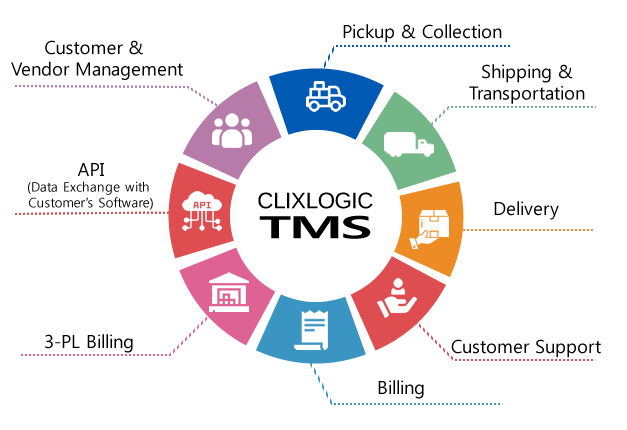
Logistics Software - Back to Basics in TMS Software
Using a Best TMS software platform is a great way to automate many of your logistics tasks. Before TMS platforms were available, dispatchers had to spend their time on the phone. They would talk to customers and brokers, and negotiate prices. Today, however, TMS can do all of these tasks and more.
Integrate with legacy systems
A TMS can integrate with existing enterprise systems, such as a Customer Relationship Management (CRM) system, to provide a more seamless and complete customer experience. It should also be able to integrate with other internal systems, such as a Warehouse Management System (WMS), so that a company can analyze the data it generates. The best TMS will have tools for data export/import so that an organization can use third-party applications. The software should have tools for creating analytical reports and maps, which help managers visually visualize shipment trends and patterns.
As the world of supply chain management continues to evolve, organizations are implementing strategic plans to transform their supply chains to become more data-driven and functional. Integrations are a critical part of this transformation. By connecting systems and stakeholders, organizations are able to gain an edge over their competitors.
Modern TMS systems provide actionable intelligence by analyzing shipments to determine which modes are most efficient. They also automate carrier selection workflows, provide real-time forecasting, and apply adaptive routing optimization. They also have interfaces that warn logistics managers of weather patterns, road closures, and other issues that can affect the delivery of their cargo. These capabilities aren’t possible with legacy systems, which require manual manipulation to gather usable data.
As the industry continues to evolve and change, companies need to adapt their existing IT systems to fit their new requirements. As a result, they must choose a system that offers the capabilities they need today, as well as those they need in the future. To do this, they should look to the Gartner Magic Quadrant. Top-rated systems often operate on a SaaS cloud platform, where users pay only for the services they need. This means that companies will save money in the long run because they only pay for what they use.
Integration with legacy systems is another way to get TMS Software Logistics integrated into your business. Many legacy systems do not have the functionality to connect with other applications, such as a legacy CRM, and it’s important to look for a system that integrates with these systems. For example, ShipHawk integrates with ERP, CRM, and eCommerce platforms, as well as a shopping cart. This allows a company to gain more control of the processes that affect their business.
With the cloud-based TMS Software, you can easily track individual shipments and locate them in warehouses. This feature is particularly useful for last-mile delivery, where tracking incoming shipments helps the logistics leader provide up-to-date status updates. With this feature, TMS software helps companies improve transparency and communication between their employees and their customers.
Cloud-based Best TMS Software solutions are a growing trend among shippers and their supply chain managers. These solutions enable shippers to access detailed data that allows them to identify inefficiencies and address them immediately. Moreover, they are able to consolidate operational tasks and integrate contracts and monetary exchanges into a single application. The cloud-based TMS solutions give companies the agility to quickly adapt to evolving industry trends.
Provide real-time visibility into shipments
TMS is an essential tool for shippers. Without real-time visibility into freight movement, they may be limited to receiving point-in-time updates from carriers (EDI 214 status codes). Real-time visibility is important because it allows shippers to react faster to incidents that could potentially impact their bottom line. But tying together multiple data feeds from carriers can be a challenge. To overcome this, Best TMS software provides a range of features and services specifically designed for this purpose.
Real-time transportation visibility (RTTVP) helps companies track loads in transit regardless of mode or carrier. The technology collects data from various sources including mobile devices, telematics networks, and electronic logging devices. The data is then fed into the TMS, where it provides a 360-degree view of the current state of shipments. This information can help operators choose the most efficient routes to move their cargo, saving time and fuel.
Moreover, Best TMS software can simplify logistical processes. It includes built-in ledger systems to handle invoicing and auditing tasks in seconds. With this technology, logistics businesses can reduce their operating costs and raise customer satisfaction. In addition to simplifying logistical processes, TMS software also provides real-time visibility of shipments.
Real-time visibility improves customer experience and increases peace of mind. It allows companies to act fast and decisively based on accurate information on inbound shipments. With real-time visibility, they can optimize routes and free up additional capacity in the process. This helps them reduce existing labor costs, which can be reallocated elsewhere.
Best TMS software also provides comprehensive metric reports and provides a multitude of custom reports. The TMS software can analyze performance data and breakdowns by state, cost, and volume. Furthermore, it can also provide a variety of charts and graphs. Using TMS software helps transportation managers make better decisions faster.
Regardless of the type of industry you’re in, CLX TMS can help. With its powerful TMS platform and best-of-breed applications, CLX TMS can provide real-time visibility into shipments. With this technology, shipping managers can make better decisions and increase profits. Moreover, the TMS software can dramatically reduce costs. It also improves visibility and efficiency across the entire supply chain.
In order to choose the right RTTVP solution, you must assess your needs and desired results. Most RTTVP vendors provide a variety of features, some of which can add considerable cost to the solution. The complexity of the solution depends on the features you need and the size of your operation. Some options include load-level tracking, product-SKU tracking, and other sophisticated features. For larger operations, a more complex solution is more suitable.
Best TMS software helps companies manage all logistics associated with shipping and transportation. It helps companies book a shipment, determine the best carrier, and monitor freight from booking to delivery. It also helps them reduce costs by optimizing loads and tracking freight across multiple routes. Lastly, the TMS software offers real-time visibility into shipments, which is a necessity for companies that want to ensure timely delivery of goods.
Connect with other software providers
With the help of logistics software , you can optimize your production planning, sourcing, procurement, packaging, dispatching, and order management. In addition, these systems help you manage recurring orders, back orders, and returns. They can also reconcile purchase orders with inventory. Moreover, these systems keep track of inventory levels and measures ship windows. They also double-check the quality and quantity of products.
In addition, these platforms connect companies with shippers, brokers, and third-party logistics providers. This integration helps companies manage complex networks of freight carriers with greater efficiency. It also helps them provide more affordable shipping services. In recent years, the number and quality of these platforms have increased. So, it is imperative to choose a logistics software provider that can support the needs of your business.
For instance, Shipwell is a leading provider of transportation software. It provides real-time visibility and is capable of scaling to meet the needs of any company. It also features modules that integrate with other systems and automate manual workflows. Finally, its real-time solutions address logistics problems in real time.










